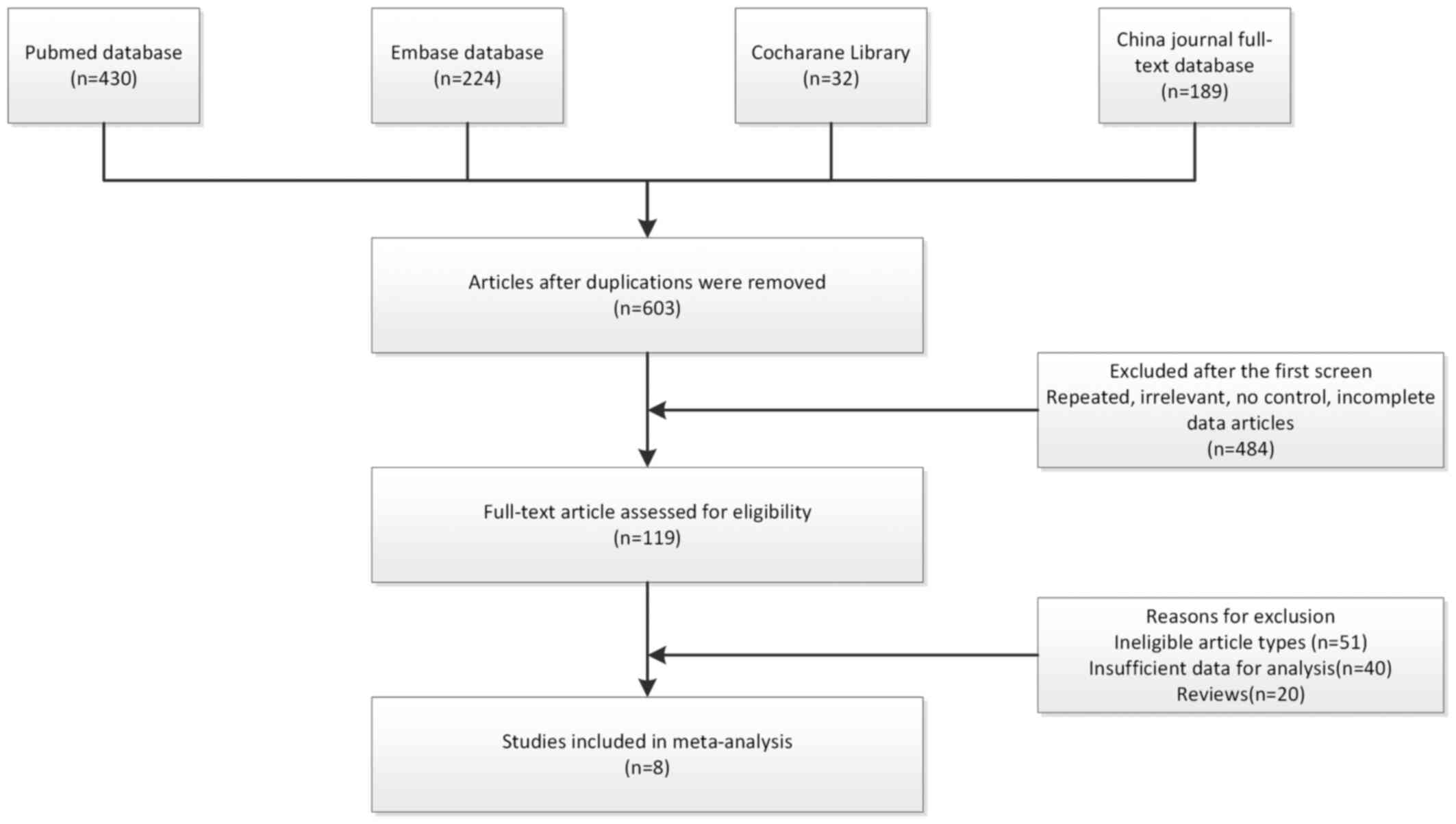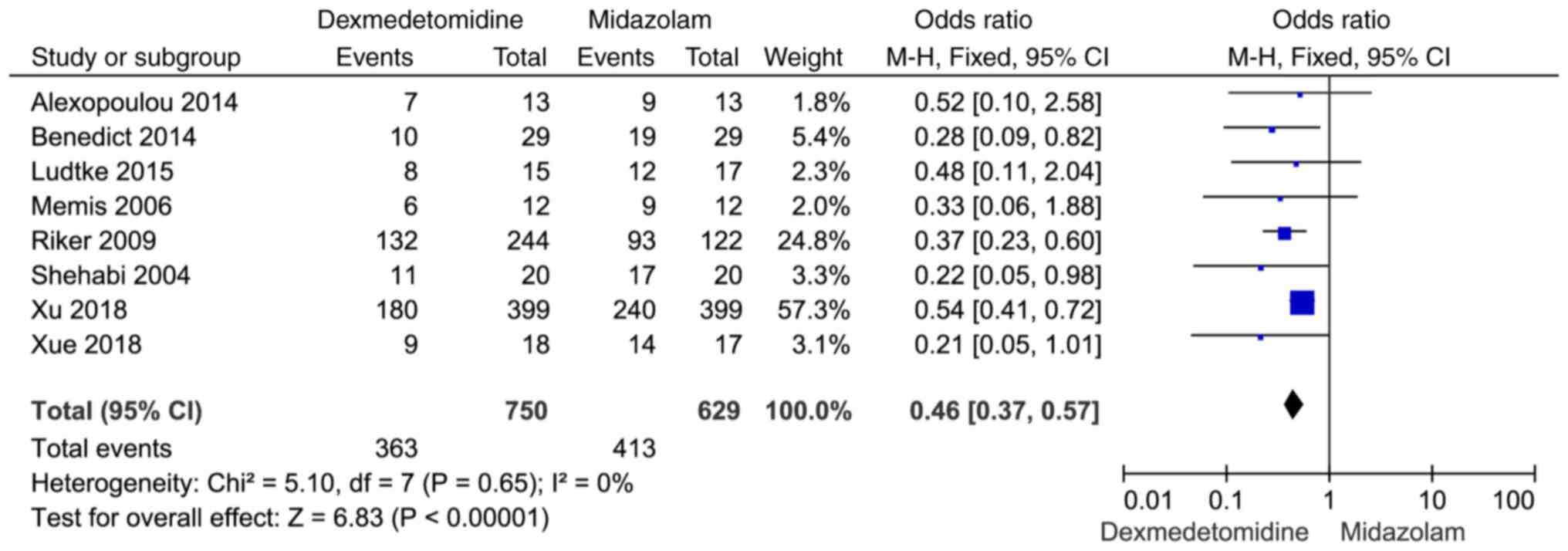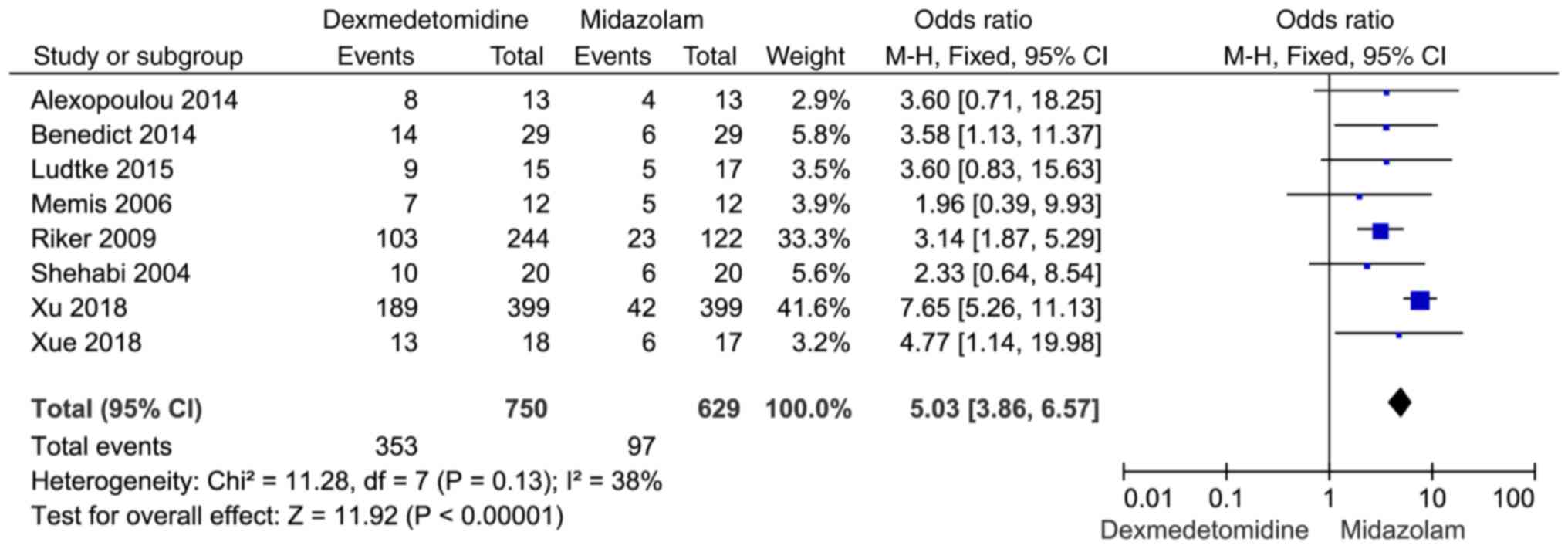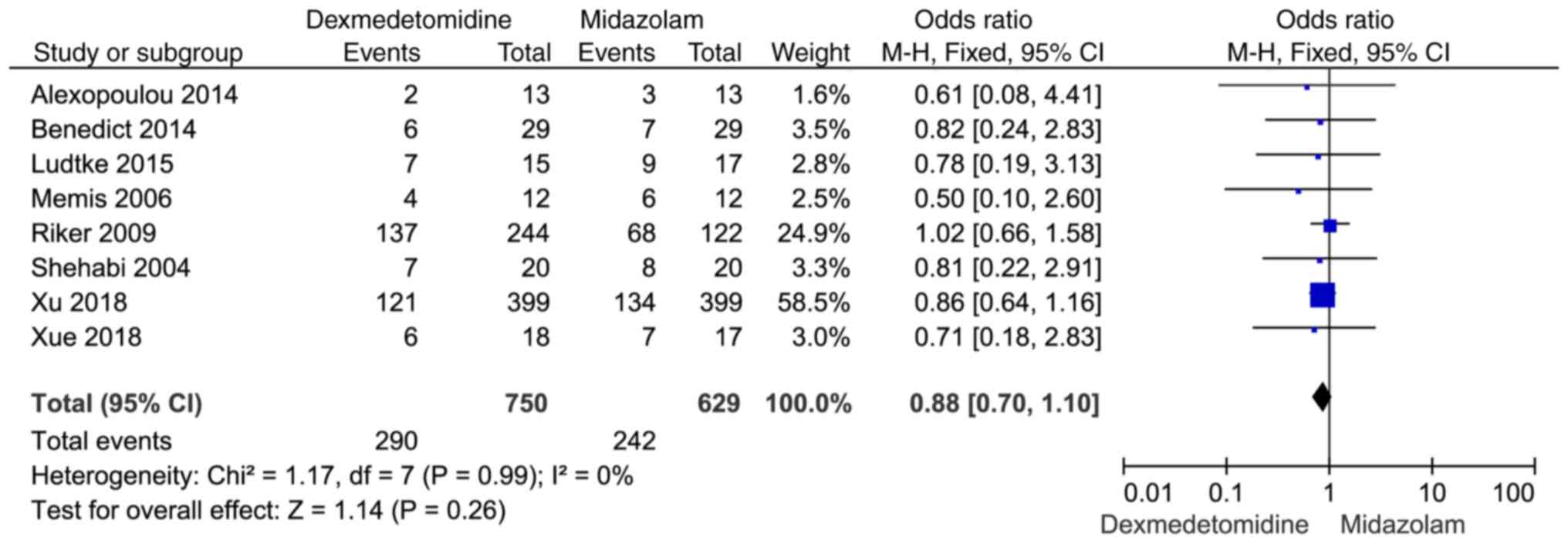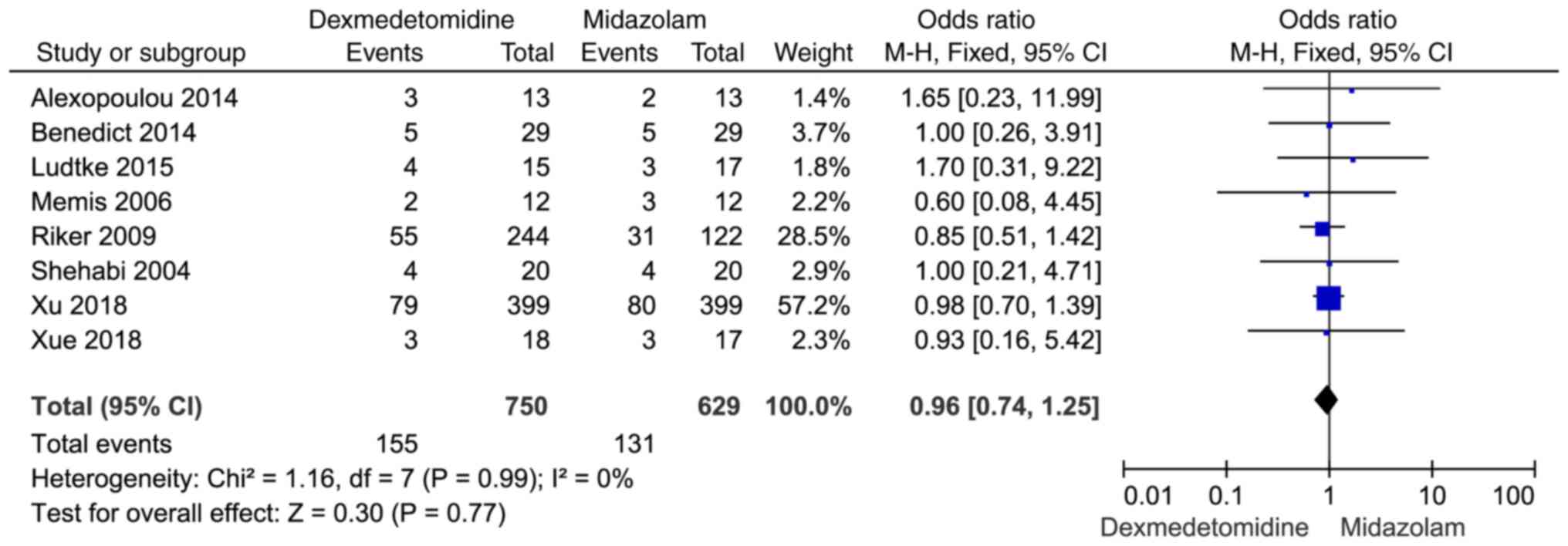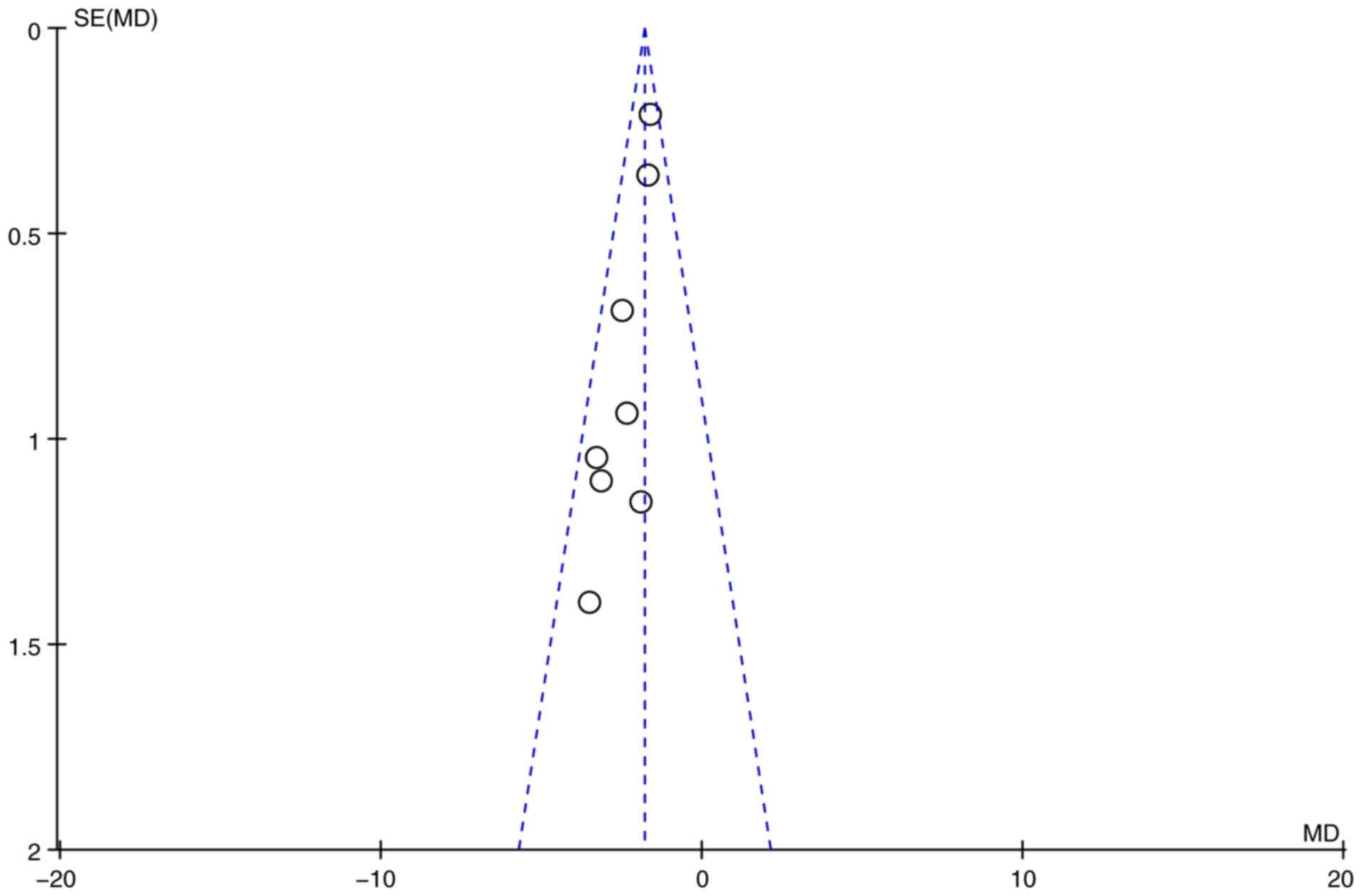Introduction
Due to environmental factors, patients in the
Intensive Care Unit (ICU) are frequently in a state of
physiological and psychological stress, which can lead to endocrine
and acid-base imbalance, hemodynamic instability, increased
metabolism and oxygen consumption (1-3).
Effective sedation can improve the comfort of ICU patients, reduce
oxygen consumption and stress response, increase tolerance to
invasive operation, avoid accidental unplugging and improve the
recovery rate (4-6).
Dexmedetomidine is a highly selective agonist for
α2-adrenergic receptors, with an affinity ratio of 1,620:l to α2:α1
receptors (7). It acts on the
adrenergic receptors in the locus coeruleus nucleus and the spinal
cord, where it possesses anti-sympathetic, sedative and analgesic
effects (7,8). In addition, dexmedetomidine can
relieve anxiety by activating presynaptic membrane α2 receptor,
inhibiting norepinephrine release and terminating pain signal
transmission.
Midazolam is a benzodiazepine sedative which
possesses a number of effects, including anti-anxiety, sedative and
hypnotic effects, anti-convulsion, muscle relaxation and
anterograde amnesia (9-11).
This agent exerts sedative and hypnotic effects by stimulating
7-aminobutyric acid receptors in the central nervous system, which
results in hypnotic responses (9).
Midazolam has been demonstrated to prolong sedation and mechanical
ventilation following long-term usage, particularly in patients
with renal failure (10). However,
some patients may also develop resistance to midazolam (12-14).
A number of studies have (6-9)
previously compared dexmedetomidine and midazolam in critically ill
patients. However, they vary in terms of research design,
recruitment and exclusion criteria established and measurement
methods performed. In the present study, randomized controlled
trials and clinical prospective studies on dexmedetomidine and
midazolam were collected. A meta-analysis was performed to
comprehensively compare the efficacy and complications of
dexmedetomidine and midazolam in patients that are critically ill.
The present study serve as an update for the comparison between
midazolam and dexmedetomidine in patients that are critically
ill.
Materials and methods
Search strategy
To fully compare the clinical effects and associated
complications of dexmedetomidine and midazolam, patients were
sedated. References between January 2005 and October 2018 were
searched in PubMed (https://pubmed.ncbi.nlm.nih.gov/), Cocharane library
(https://www.cochranelibrary.com/),
Embase (www.embase.com) and Chinese Journal
Full-text Database (https://www.cnki.net/). Systematic reviews and
meta-analysis were conducted.
Two of the authors (WZ and ML) then independently
searched for articles using the following keywords: ‘Critical
illness’, ‘dexmedetomidine OR DEX’, ‘midazolam’ and ‘sedation’. All
of these terms were assembled with the conjunction symbol ‘AND’ to
search the databases for the related articles. To obtain additional
research of high relevance and to improve the accuracy of
subsequent analysis, the reference list of each article retrieved
was also reviewed.
Citation selection
Following the initial screening, all articles were
vetted further by two other authors (WZ and XF), where the titles
and abstracts of these articles were independently and carefully
screened. If the research article was relevant, the full-text
article was then selected. There was no restriction on language and
the publication period was between January 2005 and October
2018.
The inclusion criteria were as follows: i) A
randomized controlled trial or a controlled clinical trial; ii)
comparison of the clinical effects and mortality of dexmedetomidine
and midazolam; iii) patients that are critically ill (patients
whose condition is acute, critical and rapidly changing) were
included; and iv) full text articles were available. Exclusion
criteria were as follows: i) Non-randomized study; ii) studies on
treatments other than dexmedetomidine or midazolam; iii) patients
that are critically ill were not included; iv) studies lacking
outcome measures or comparable results; and v) duplicated
publications and incomplete data or articles.
Finally, the two researchers (ML and XF) jointly
examined whether the article of interest met the aforementioned
requirements. If there were any differences and no agreement could
be reached, a third investigator (WZ) helped to make the
decision.
Data extraction
The two reviewers (WZ and ML) read the full text,
extracted the relevant data from each study and inserted them into
a coding table in the Microsoft Excel software (Microsoft
Corporation; version, 2013). The characteristics extracted in the
present study included the name of the first author, publication
year, year of onset, sample size (dexmedetomidine/midazolam), age
range of patients and outcome parameters. The parameters were the
clinical effects and complications of dexmedetomidine and
midazolam, including length of stay in ICU, time to extubation,
delirium, bradycardia, hypotension and mortality.
Statistical analysis
Meta-analysis was performed using Retrospective
Manager 5.0 (2011; Cochrane Collaboration) to assess differences in
clinical effects and complications between dexmedetomidine and
midazolam and publication bias.
Q-statistics can be used to reflect the level of
heterogeneity (3). When the
heterogeneous I2 statistic was >50%, the random
effects model was used due to moderate or high heterogeneity;
otherwise, the fixed effects model was selected.
Sensitivity analysis of bias was performed using
Quality Assessment of Diagnostic Accuracy Studies-2 (QUADAS-2;
http://www.bristol.ac.uk/population-health-sciences/projects/quadas/quadas-2/)
tool, where the quality of the article and risk of bias in each
study were assessed using the following criteria: i) Random
sequence generation; ii) allocation concealment; iii) blinding of
participants and researchers; iv) blinding of outcome assessment;
v) incomplete outcome data; vi) selective reporting; and vii) other
bias. In the present study, all parameters including length of ICU
stay, time to extubation, incidence of delirium, incidence of
bradycardia, hypotension and mortality were collected and the odds
ratio (OR) and 95% confidence interval (CI) were calculated. Funnel
plots together with Egger tests were applied to assess publication
bias. P<0.05 was considered to indicate a statistically
significant difference.
Results
Search results
A preliminary search identified 603 related titles
and abstracts in the electronic databases. After a thorough review,
8 studies (15-22)
eventually met the inclusion criteria for final analysis. A total
of 595 articles were excluded due to irrelevant studies (n=484),
lack of a control group (n=51), incomplete data or comparisons
(n=40) or review articles (n=20). Fig.
1 represents a flowchart of the search process, which
summarizes the identification, inclusion and exclusion of studies
for the present analysis.
Characteristics of the included
studies
Table I lists the
first author's name, year of publication, sample size
(dexmedetomidine/midazolam), age range of patients and the study
period. All included studies were published between 2004 and 2018.
The sample size of included studies ranged between 24 and 798. The
present study had 1,379 critically ill patients, including 750 in
the dexmedetomidine group and 629 in the midazolam group.
 | Table ICharacteristics of the included
studies. |
Table I
Characteristics of the included
studies.
| Author, year | Language | Country | Age (range),
years | Sex
(male/female) | Groups | n | Study period | (Refs.) |
|---|
| Alexopoulou et
al, 2014 | English | Greece | 59±10.3 (55-69) | 20/6 | Dexmedetomidine
Midazolam | 13 13 | October 2011-November
2013 | (15) |
| Benedict et
al, 2014 | English | USA | 48±5.9 (39-61) | 34/24 | Dexmedetomidine
Midazolam | 29 29 | February 2011-May
2011 | (16) |
| Ludtke et al,
2015 | English | USA | 48.7±7.8 (28-59) | 27/5 | Dexmedetomidine
Midazolam | 15 17 | March 2002-April
2009 | (17) |
| Memis et al,
2006 | English | Turkey | 46±9.4 (19-65) | 15/9 | Dexmedetomidine
Midazolam | 12 12 | 2001-2003 | (18) |
| Riker et al,
2009 | English | USA | 62.1±13.4
(18-69) | 246/120 | Dexmedetomidine
Midazolam | 244 122 | March 2005-August
2007 | (19) |
| Shehabi et
al, 2004 | English | Australia | 61±15 (37-77) | 31/9 | Dexmedetomidine
Midazolam | 20 20 | 2000-2002 | (20) |
| Xu et al,
2018 | English | China | 57.8±13.2
(21-76) | 477/321 | Dexmedetomidine
Midazolam | 399 399 | 2011-2012 | (21) |
| Xue et al,
2018 | English | China | 58.4±11.2
(19-75) | 21/14 | Dexmedetomidine
Midazolam | 18 17 | 2012-2014 | (22) |
Quality assessment
The deviation table generated using the QUADAS-2
tool under the instruction of the Review Manager 5.0 tutorial, was
used to assess the risk of each study to bias by applying the
criteria for evaluating design-related deviations. The risk of bias
in the studies is provided in Table
II. Participants and personnel in all included studies
exhibited high risks of blindness bias due to the research design
between dexmedetomidine and midazolam.
 | Table IIThe risk of bias table in the present
study. |
Table II
The risk of bias table in the present
study.
| Author, year | Random sequence
generation | Allocation
concealment | Blinding of
participants and personnel | Blinding of outcome
assessment | Incomplete outcome
data | Selective
reporting | Other bias | (Refs.) |
|---|
| Alexopoulou et
al, 2014 | Low risk | Low risk | High risk | Not clear | Not clear | High risk | Not clear | (15) |
| Benedict et
al, 2014 | Not clear | Low risk | High risk | Low risk | Low risk | High risk | Low risk | (16) |
| Ludtke et
al, 2015 | Not clear | High risk | High risk | High risk | Low risk | Not clear | Not clear | (17) |
| Memis et al,
2006 | Low risk | High risk | High risk | Low risk | Not clear | Low risk | Low risk | (18) |
| Riker et al,
2009 | Low risk | High risk | High risk | Low risk | Not clear | Low risk | Low risk | (19) |
| Shehabi et
al, 2004 | High risk | Low risk | High risk | Low risk | Low risk | Low risk | Not clear | (20) |
| Xu et al,
2018 | High risk | Low risk | High risk | Low risk | Low risk | Not clear | Not clear | (21) |
| Xue et al,
2018 | Low risk | Low risk | High risk | Not clear | Low risk | Low risk | Low risk | (22) |
Results of meta-analysis Length of ICU
stay
The list of outcomes in terms of clinical effects
collected include the length of ICU stay and the time to
extubation. All eight studies involved patients requiring ICU stay.
Fig. 2 shows a forest map of the
length of ICU stay required by patients in the dexmedetomidine and
the midazolam groups. All 8 studies demonstrated statistically
significant differences in the length of ICU stay between
dexmedetomidine and midazolam. The meta-analysis suggested that
difference in the length of ICU stay in dexmedetomidine and
midazolam was significant [mean absolute difference (MD)=-1.80; 95%
confidence interval (CI), -2.13, -1.48; P<0.00001; P-value for
heterogeneity=0.41; I²=3%]. The length of ICU stay by patients
receiving midazolam (9.93 days) was longer compared with patients
receiving dexmedetomidine (7.44 days).
Time to extubation
The forest plot for the meta-analysis of time to
extubation is presented in Fig. 3.
The results demonstrated that the time to extubation in the
midazolam group (6.48 days) was higher compared with that of the
dexmedetomidine group (4.01 days; MD=-2.18; 95% CI, -2.66, -1.69;
P<0.00001; P-value for heterogeneity=0.84; I²=0%).
Incidence of delirium
Complications recorded included delirium,
bradycardia and hypotension. The occurrence of delirium in all the
included studies are shown in Fig.
4. The overall result indicated that the incidence of delirium
in patients treated with midazolam was higher compared with that in
patients treated with dexmedetomidine [odds ratio (OR)=0.46; 95%
CI, 0.37, 0.57; P<0.00001; P-value for heterogeneity=0.65;
I²=0%].
Incidence of bradycardia
The occurrence of bradycardia reported in all eight
of the studies is shown in Fig. 5.
The overall result indicated that the incidence of bradycardia in
the dexmedetomidine group was higher compared with that of the
midazolam group (OR=5.03; 95% CI, 3.86, 6.57; P<0.00001; P-value
for heterogeneity=0.13, I²=38%).
Meta-analysis of hypotension
All studies with data on hypotension are presented
in Fig. 6. The overall result
indicated that there was no difference in the incidence of
hypotension between the dexmedetomidine and the midazolam groups
(OR=0.88; 95% CI, 0.70, 1.10; P=0.26; P-value for
heterogeneity=0.99; I²=0%).
Mortality
The eight studies with data on mortality are shown
in Fig. 7. The overall result
indicated that there was no difference in the mortality rate
between the dexmedetomidine and the midazolam groups (OR=0.96; 95%
CI. 0.74, 1.25; P=0.77; P-value for heterogeneity=0.99; I²=0%).
Sensitivity analysis
Since heterogeneity is a measure of the variation
among the effect sizes of the included studies, changes in it can
reflect the stability of the meta-analysis (23). According to the meta-analysis in the
present study, heterogeneity of the length of ICU stay was low
(I2=3%). As shown in Fig.
8, the low heterogeneity in the length of ICU stay may be
attributed to the different results of each study. Since the
difference in I² was the most prominent following the exclusion of
the study by Xue et al (22), this study was excluded. As such, the
I2 rose from 3 to 17%.
Bias analysis
Funnel plots of the length of ICU stay in the
dexmedetomidine and the midazolam groups were performed. All
studies are included in the plot. The results demonstrated that the
funnel plot had medium symmetry with minimal publication bias
(Fig. 9).
Discussion
Patients in critical care in the ICU experience
severe stress due to underlying diseases, sleep deprivation,
anxiety, pain, tracheal intubation, tracheotomy among other factors
(23-25).
Analgesia and sedation therapy have become an important part of
patient management in the ICU.
Midazolam is a benzodiazepine sedative that is
associated with effects, including anti-anxiety, sedative and
hypnotic effects, anti-convulsion, muscle relaxation and
anterograde amnesia (26-28).
By contrast, dexmedetomidine confers advantages including sedation,
cooperation and communication after awakening, such that it can
reduce the demand for analgesics (27). Dexmedetomidine used for treating
patients with infection, sepsis and systemic inflammatory reactions
has not been demonstrated to increase the risk of side effects
(29,30). In addition, it can effectively
prevent the incidence of delirium and shorten the length of ICU
stay (30).
In the present study, the difference in the length
of ICU stay in patients receiving dexmedetomidine and midazolam was
found to be significant, whilst the time to extubation in patients
receiving midazolam was higher compared with patients receiving
dexmedetomidine. These results demonstrated that dexmedetomidine
could reduce the duration of ICU stay and extubation, suggesting
that dexmedetomidine administration resulted in superior clinical
outcomes and shorter recovery times compared with midazolam. Ma
et al (31) previously
reported that dexmedetomidine can significantly shorten the
recovery time and extubation time of patients, which may be related
to the reduction of propofol and fentanyl dosage by
dexmedetomidine. Results from the present study is consistent with
those observed by Ma et al Additionally, Romagnoli et
al (32) stated previously that
dexmedetomidine represents an optimal choice for sedation of
patients that are critically ill due to its unique properties in
calming patients and increasing cooperativity by providing (light)
sedation and analgesia. It can be used as an effective drug to
induce light sedation, analgesia and quasi-physiological sleep in
patients that are critically ill. Considering the results of ICU
stay and time to extubation, the results demonstrated that
dexmedetomidine is effective for inducing light sedation for
patients that are critically ill.
The incidence of delirium in patients receiving
midazolam was found to be higher compared with that in patients
receiving dexmedetomidine, whilst the incidence of bradycardia in
patients receiving dexmedetomidine was higher compared with that in
patients receiving midazolam. This observation is consistent with
that reported by the study of Yao et al (33), which demonstrated that
dexmedetomidine, is a novel and highly selective agonist of the α2
adrenergic receptor resulting in analgesic effects. Sedation for
severe patients can shorten the length of ICU stay, reduce the
incidence of delirium and improve the outcome of patients that are
critically ill (30). Romagnoli
et al (32), also reported
that dexmedetomidine can provide a fundamental support for the
prevention and treatment of delirium in patients that are
critically ill, demonstrating that dexmedetomidine can prevent
adverse effects.
The overall results of the present study indicated
that the occurrence of hypotension and mortality in patients
receiving dexmedetomidine and midazolam did not differ. The results
of mortality and complications indicated that dexmedetomidine and
midazolam exerted little difference in terms of the safety of
sedation in patients that are critically ill. This consistent with
previous studies (4,6).
The present study has a number of limitations.
Additional indicators, such as recovery time in both the
dexmedetomidine and midazolam groups could have been analyzed,
which should be evaluated in the future. Furthermore, additional
articles should also be included for further research.
In the present study, low heterogeneities were
obtained in the meta-analysis. According to the funnel plots, no
publication bias was observed, further validating the results.
Compared with midazolam, dexmedetomidine is the preferred
anesthetic for patients that are critically ill. The present study
can facilitate anesthesiologists in the selection of anesthetic
agents for patients that are critically ill.
Acknowledgements
Not applicable.
Funding
The present study was supported by Nature Science
Foundation of Hubei Province (grant no. 2018CFB353) and the Wuhan
Health and Family Planning Commission Young and Middle-aged Medical
Backbone Talent Fund (grant no. (2018)116).
Availability of data and materials
The datasets used and/or analyzed during the present
study are available from the corresponding author on reasonable
request.
Authors' contributions
WZ and XF made substantial contributions to
conception and design of the study. WZ, ML and XF searched
literature, extracted data from the collected literature and
analyzed the data. WZ wrote and XF revised the manuscript. All
authors reviewed and approved the final manuscript.
Ethics approval and consent to
participate
Not applicable.
Patient consent for publication
Not applicable.
Competing interests
The authors declare that they have no competing
interests.
References
|
1
|
Chang YF, Chao A, Shih PY, Hsu YC, Lee CT,
Tien YW, Yeh YC and Chen LW: NTUH Center of Microcirculation
Medical Research (NCMMR). Comparison of dexmedetomidine versus
propofol on hemodynamics in surgical critically ill patients. J
Surg Res. 228:194–200. 2018.PubMed/NCBI View Article : Google Scholar
|
|
2
|
Tan JA and Ho KM: Use of dexmedetomidine
as a sedative and analgesic agent in critically ill adult patients:
A meta-analysis. Intensive Care Med. 36:926–939. 2010.PubMed/NCBI View Article : Google Scholar
|
|
3
|
Memiş D, Hekimoğlu S, Vatan I, Yandim T,
Yüksel M and Süt N: Effects of midazolam and dexmedetomidine on
inflammatory responses and gastric intramucosal pH to sepsis, in
critically ill patients. Br J Anaesth. 98:550–552. 2007.PubMed/NCBI View Article : Google Scholar
|
|
4
|
Shehabi Y, Nakae H, Hammond N, Bass F,
Nicholson L and Chen J: The effect of dexmedetomidine on agitation
during weaning of mechanical ventilation in critically ill
patients. Anaesth Intensive Care. 38:82–90. 2010.PubMed/NCBI View Article : Google Scholar
|
|
5
|
Gerlach AT, Dasta JF, Steinberg S, Martin
LC and Cook CH: A new dosing protocol reduces
dexmedetomidine-associated hypotension in critically ill surgical
patients. J Crit Care. 24(568)2009.PubMed/NCBI View Article : Google Scholar
|
|
6
|
Iirola T, Aantaa R, Laitio R, Kentala E,
Lahtinen M, Wighton A, Garratt C, Ahtola-Sätilä T and Olkkola KT:
Pharmacokinetics of prolonged infusion of high-dose dexmedetomidine
in critically ill patients. Crit Care. 15(R257)2011.PubMed/NCBI View
Article : Google Scholar
|
|
7
|
Gupta P, Whiteside W, Sabati A, Tesoro TM,
Gossett JM, Tobias JD and Roth SJ: Safety and efficacy of prolonged
dexmedetomidine use in critically ill children with heart disease*.
Pediatr Crit Care Med. 13(660)2012.PubMed/NCBI View Article : Google Scholar
|
|
8
|
Guinter JR and Kristeller JL: Prolonged
infusions of dexmedetomidine in critically ill patients. Am J
Health Syst Pharm. 67:1246–1253. 2010.PubMed/NCBI View Article : Google Scholar
|
|
9
|
Burbano NH, Otero AV, Berry DE, Orr RA and
Munoz RA: Discontinuation of prolonged infusions of dexmedetomidine
in critically ill children with heart disease. Intensive Care Med.
38:300–307. 2012.PubMed/NCBI View Article : Google Scholar
|
|
10
|
Lin H, Faraklas I, Sampson C, Saffle JR
and Cochran Al: Use of dexmedetomidine for sedation in critically
ill mechanically ventilated pediatric burn patients. J Burn Care
Res. 32(98)2008.PubMed/NCBI View Article : Google Scholar
|
|
11
|
Demuro JP, Botros DG, Wirkowski E and
Hanna AF: Use of dexmedetomidine for the treatment of alcohol
withdrawal syndrome in critically ill patients: A retrospective
case series. J Anesth. 26:601–605. 2012.PubMed/NCBI View Article : Google Scholar
|
|
12
|
Kress JP, O'Connor MF, Pohlman AS, Olson
D, Lavoie A, Toledano A and Hall JB: Sedation of critically ill
patients during mechanical ventilation. A comparison of propofol
and midazolam. Am J Respir Crit Care Med. 153:1012–1018.
1996.PubMed/NCBI View Article : Google Scholar
|
|
13
|
Shelly MP, Mendel L and Park GR: Failure
of critically ill patients to metabolise midazolam. Anaesthesia.
42:619–626. 1987.PubMed/NCBI View Article : Google Scholar
|
|
14
|
Barrientos-Vega R, Mar Sánchez-Soria M,
Morales-García C, Robas-Gómez A, Cuena-Boy R and Ayensa-Rincon A:
Prolonged sedation of critically ill patients with midazolam or
propofol: Impact on weaning and costs. Crit Care Med. 25:33–40.
1997.PubMed/NCBI View Article : Google Scholar
|
|
15
|
Alexopoulou C, Kondili E, Diamantaki E,
Psarologakis C, Kokkini S, Bolaki M and Georgopoulos D: Effects of
dexmedetomidine on sleep quality in Critically Ill patients: A
pilot study. Anesthesiology. 121:801–807. 2014.PubMed/NCBI View Article : Google Scholar
|
|
16
|
Benedict N, Felbinger M, Ridenour T,
Anthes A, Altawalbeh S and Kane-Gill S: Correlation of
patient-reported outcomes of sedation and sedation assessment
scores in critically ill patients. J Crit Care. 29:1132.e5–e9.
2014.PubMed/NCBI View Article : Google Scholar
|
|
17
|
Ludtke KA, Stanley KS, Yount NL and Gerkin
RD: Retrospective review of Critically Ill patients experiencing
alcohol withdrawal: Dexmedetomidine versus propofol and/or
lorazepam continuous infusions. Hosp Pharm. 50:208–213.
2015.PubMed/NCBI View Article : Google Scholar
|
|
18
|
Memiş D, Dökmeci D, Karamanlioğlu B, Turan
A and Türe M: A comparison of the effect on gastric emptying of
propofol or dexmedetomidine in critically ill patients: Preliminary
study. Eur J Anaesthesiol. 23:700–704. 2006.PubMed/NCBI View Article : Google Scholar
|
|
19
|
Riker RR, Shehabi Y, Bokesch PM, Ceraso D,
Wisemandle W, Koura F, Whitten P, Margolis BD, Byrne DW, Ely EW, et
al: Dexmedetomidine vs midazolam for sedation of critically Ill
patients: A randomized trial. JAMA. 301:489–499. 2009.PubMed/NCBI View Article : Google Scholar
|
|
20
|
Shehabi Y, Ruettimann U, Adamson H, Innes
R and Ickeringill M: Dexmedetomidine infusion for more than 24
hours in critically ill patients: Sedative and cardiovascular
effects. Intensive Care Med. 30:2188–2196. 2004.PubMed/NCBI View Article : Google Scholar
|
|
21
|
Xu F, Wang Q, Chen S, Ao H and Ma J: The
association between intraoperative dexmedetomidine and 1 year
morbidity and mortality after cardiac surgery: A propensity matched
analysis of over 1400 patients. J Clin Anesth. 50:70–75.
2018.PubMed/NCBI View Article : Google Scholar
|
|
22
|
Xue Y, Yuan H and Chen Y: Effects of
dexmedetomidine as an adjunct in transversus abdominis plane block
during gynecological laparoscopy. Exp Ther Med. 16:1131–1136.
2018.PubMed/NCBI View Article : Google Scholar
|
|
23
|
Hughes J, Gill A, Leach HJ, Nunn AJ,
Billingham I, Ratcliffe J, Thornington R and Choonara I: A
prospective study of the adverse effects of midazolam on withdrawal
in critically ill children. Acta Pædiatr. 83:1194–1199.
1994.PubMed/NCBI View Article : Google Scholar
|
|
24
|
Spina SP and Ensom MH: Clinical
pharmacokinetic monitoring of midazolam in critically ill patients.
Pharmacotherapy. 27:389–398. 2007.PubMed/NCBI View Article : Google Scholar
|
|
25
|
Mccollam JS, O'Neil MG, Norcross ED, Byrne
TK and Reeves ST: Continuous infusions of lorazepam, midazolam, and
propofol for sedation of the critically ill surgery trauma patient:
A prospective, randomized comparison. Crit Care Med. 27:2454–2458.
1999.PubMed/NCBI View Article : Google Scholar
|
|
26
|
Jacqz-Aigrain E, Daoud P, Burtin P,
Maherzi S and Beaufils F: Pharmacokinetics of midazolam during
continuous infusion in critically ill neonates. Eur J Clin
Pharmacol. 42:329–332. 1992.PubMed/NCBI View Article : Google Scholar
|
|
27
|
Shafer A, Doze VA and White PF:
Pharmacokinetic variability of midazolam infusions in critically
ill patients. Crit Care Med. 18:1039–1041. 1990.PubMed/NCBI View Article : Google Scholar
|
|
28
|
Swart EL, Zuideveld KP, de Jongh J, Danhof
M, Thijs LG and Strack van Schijndel RM: Comparative population
pharmacokinetics of lorazepam and midazolam during long-term
continuous infusion in critically ill patients. Br J Clin
Pharmacol. 57:135–145. 2004.PubMed/NCBI View Article : Google Scholar
|
|
29
|
Dirksen MS, Vree TB and Driessen JJ:
Clinical pharmacokinetics of long-term infusion of midazolam in
critically ill patients-preliminary results. Anaesth Intensive
Care. 15:440–444. 1987.PubMed/NCBI View Article : Google Scholar
|
|
30
|
Kirwan CJ, MacPhee IA, Lee T, Holt DW and
Philips BJ: Acute kidney injury reduces the hepatic metabolism of
midazolam in critically ill patients. Intensive Care Med. 38:76–84.
2012.PubMed/NCBI View Article : Google Scholar
|
|
31
|
Ma C: Effect of dexmedetomidine on
postoperative delirium in elderly patients with severe diseases.
Chin J Geriatr. 34:141–143. 2015.
|
|
32
|
Romagnoli S, Amigoni A, Blangetti I,
Casella G, Chelazzi C, Forfori F, Garisto C, Mondardini MC,
Moltrasio M, Pasero D, et al: Light sedation with dexmedetomidine:
A practical approach for the intensivist in different ICU patients.
Minerva Anestesiol. 84:731–746. 2018.PubMed/NCBI View Article : Google Scholar
|
|
33
|
Yao Y-Q and Dong-Xin W: The effect of
dexmedetomidine on the incidence of postoperative delirium in
critically ill elderly patients. J Clin Anesthesiol, 2012.
|















